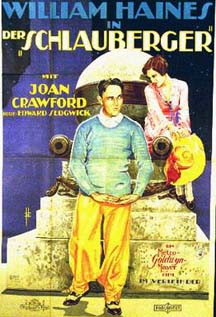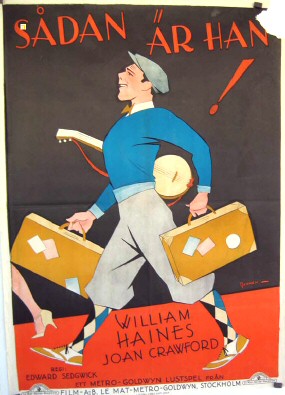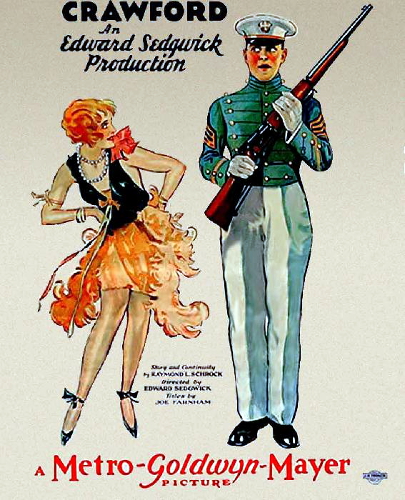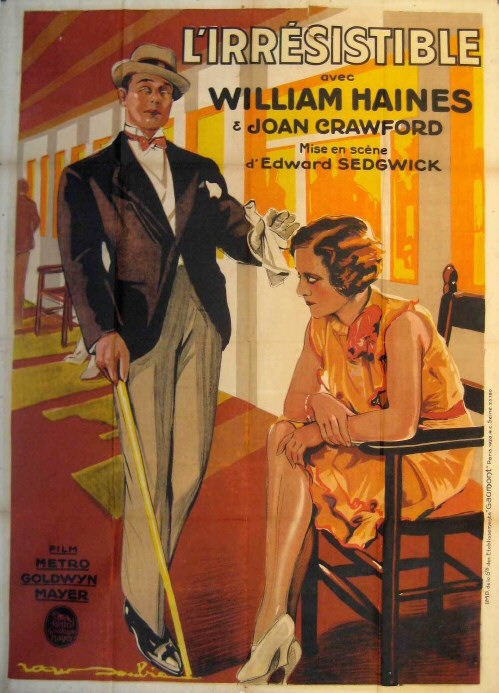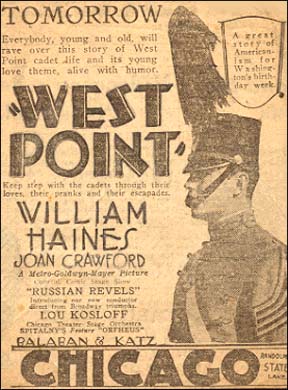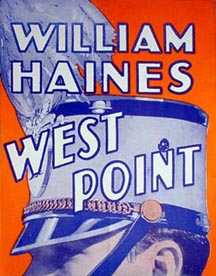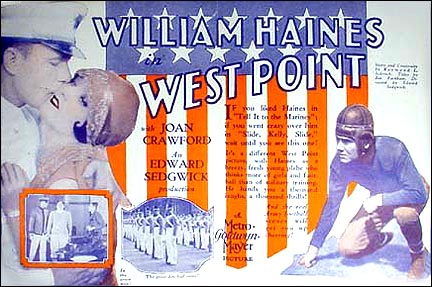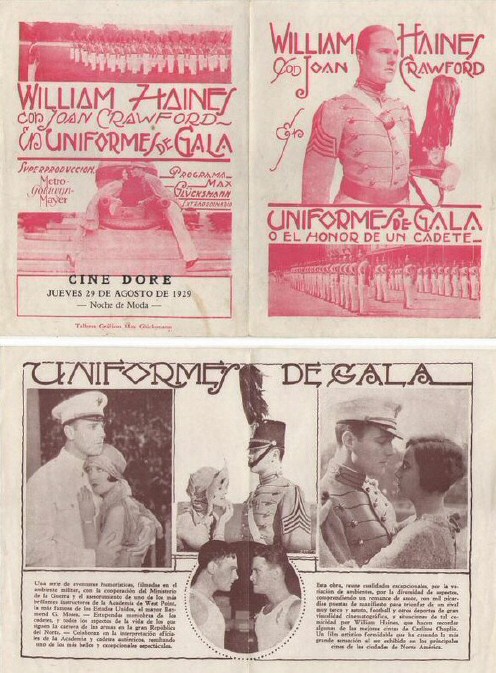|
 Tom C.
(June 2021) Tom C.
(June 2021)
Rating:
   -1/2
of 5 -1/2
of 5
If you've seen one Billie Haines silent movie, you've
seen them all. A gross oversimplification, but folks must have liked the
formula, because Haines was a top box office draw at MGM in the late
20s/early 30s until forced to choose between his male lover or his film
career. He chose his partner. Eventually, Haines reinvented himself as
Interior Decorator to the Stars, thanks in part to his good bud, Joan
Cranberry. Oops, I mean Joan Crawford!
Back
to the formula: Haines is an arrogant jock who needs --- and eventually
gets --- a dose of comeuppance. The only variables seem to be the sport
he excels at and the leading lady who helps Haines find his better
self. In West Point, Haines is a star football player at the USMA and JC
is the daughter of a local innkeeper.
One
of the best parts of this movie is the chemistry between Joan and
Billie. Especially the opening scene, where he pretends to be a blind man
to meet Crawford, and the mildly naughty ditties he plays for her on
his ukelele in a later scene. They look and work great together. Much of
the time in these scenes, Joan looks like she's trying hard to keep a
straight face for the camera. And, what a face it is! Joan is on the
cusp of fame and becoming a more accomplished actress, and I think she
never looked more lovely than in her final silent films.
Haines'
character, Brice, has much success on the football field. And his ego
grows out of control as a result. Eventually, he sees himself as bigger
than the Corps and is thus ostracized. His roomie, Tex, goes to bat for
Brice with the Honor Committee. There is the eventual epiphany for
Brice, hastened by an emotional hospital meeting with Tex. Thus, Brice
regains the spirit of the Corps just in time to sink the Navy in the big
game, and gain the forgiveness of his teammates, and, most importantly, the
love of Joan.
I like
this movie. It's cute, light entertainment. Haines is his usual
smart-alecky and charming self, and JC looks like a million bucks and acts
well when called on to do so. There's not much for her, though, as this
is a Haines vehicle all the way. William Bakewell, who appears again in
the JC filmography as her brother in 1931's Dance, Fools, Dance, turns
in a great performance as Tex.
Mammy!! :)
 Stephanie
Jones
(August 2005) Stephanie
Jones
(August 2005)
Rating:
  -1/2
of 5 -1/2
of 5
West
Point is first and foremost a vehicle for William
Haines, then at the peak of his career as a comedic-romantic leading man at
MGM. Joan, as Haines' love interest "Betty Channing," disappears from
the story for long stretches and is given little to do other than wear the latest
collegiate fashions and alternately crack up and/or look annoyed at Haines'
character's antics. She's pretty much eye-candy here; the point of her
being onhand is to react to Haines and look stylish while doing so; this she
does do with eye-catching verve.
Despite
its entertaining start, the film (shot on location at West Point and with Army
officials on board the project as advisers), quickly becomes a propaganda piece
for the West Point Army academy and its "Spirit of the Corps" credo.
(Though Joan, offscreen, managed to throw a spanner in the official
works when, according to TCM, she got a cadet expelled for sneaking off-campus
to party with her.)
Haines
plays cheeky, hot-headed cadet Brice Wayne, who's initially quick with the wisecracks
and unwilling to take school traditions and spirit very seriously. Haines' sassy
first scenes aboard ship with Joan are the highlight of the picture: His "inspection
of the troops" and pretending to be blind to get Betty's attention are
cleverly written and slyly, goofily acted.
Equally
funny hijinx ensue when the ship docks and Brice follows Betty to her mother's
hotel: Betty's there with a strait-laced beau and Brice proceeds to stir up
the joint with some crazily manic banjo playing and risque songs, punctuated
by nonsensical shrieks of "MAMMY!" (In one funny bit, Brice's
friend looks on, admiring Brice's success at charming Betty. The friend then
picks up a banjo himself and tries to similarly woo another young lady on the
porch of the hotel---only, his own outbursts of "MOTHER!" somehow
fail to impress. Sidenote:
This friend was played somewhat old-fashionedly but with beautifully luminous eyes
by William Bakewell, whose later primary claim to fame was in Gone
With the Wind---he's the soldier on horseback
who warns Scarlett that she better get out of Atlanta because the Yankees are
coming.)
Haines'
initial scenes of training as a cadet are also irreverently amusing: His spoiled
rich-boy character asks for a room with a Southern exposure, lazily lolls about
when reveille is played, shows up for inspection wearing golf togs and carrying
his clubs. Unfortunately, this halfway point of the film is where, for the most
part, the fun ends and the more boring "morality tale" begins, to
the detriment of the overall story. Brice must, of course, learn to conform
to the strict standards of the military school, where wisecracking and spouting
off "To Hell with the Corps!" when you're benched during football
practice are decidedly frowned upon. (Brice has also transgressed by manhandling
Betty; this, too, must be atoned for.)
Haines
is a very skillful actor---not only a fine physical (and facial) comedian, but
also very adept and believable in his more serious scenes. It's just that the
second half of the film lays all of the "What it means to be an officer
and a gentleman" stuff on pretty thick and predictably, complete with the
"Best Friend"'s sickbed exhortations to success as well as a final
(here, pretty long and boring) Big Game, in which Brice shows what a hero and
team player he can be.
While
the first half of the film is very entertaining because of Haines' offbeat and
clever antics (as well as the acting rapport between Haines and Joan---she's
obviously very in tune with what he's doing and genuinely amused by his shenanigans),
the second half loses a lot of steam when it starts reining Haines in and focusing
instead on the "by-the-book" storytelling and morality lesson.
|
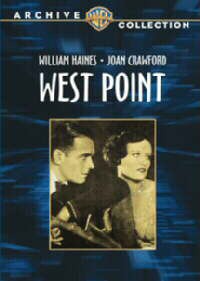 MGM. 80 minutes.
MGM. 80 minutes.


